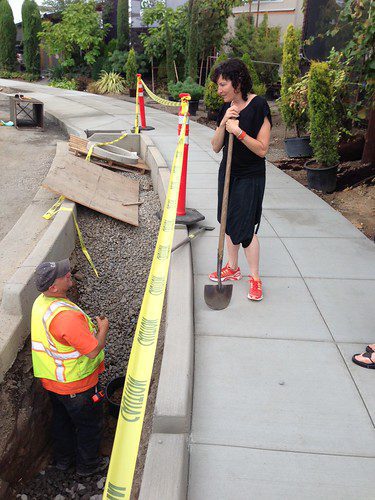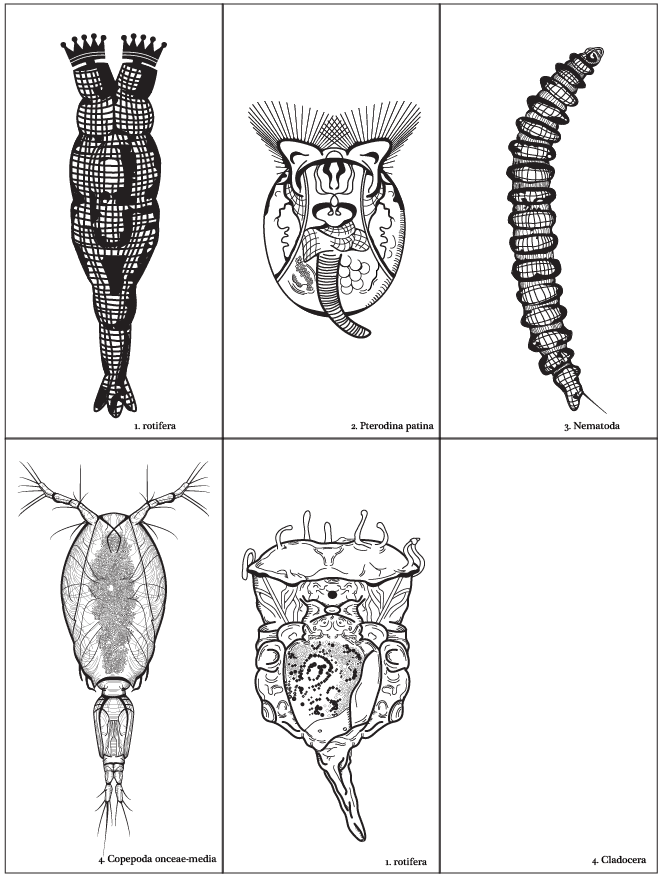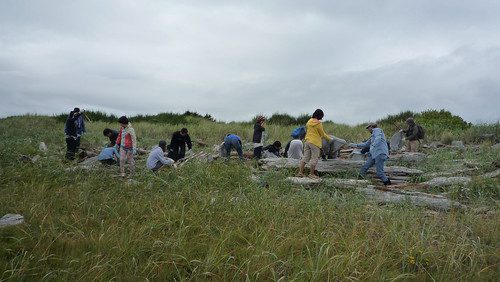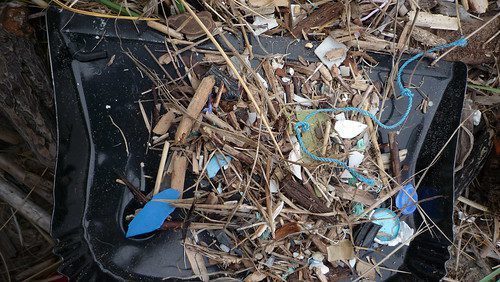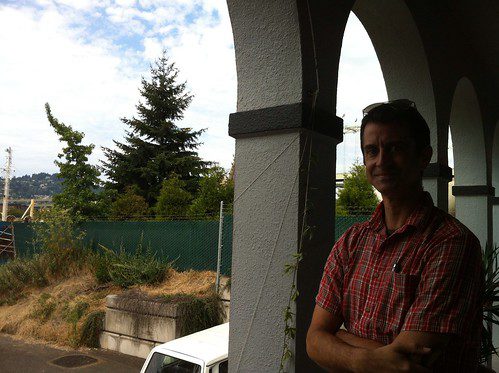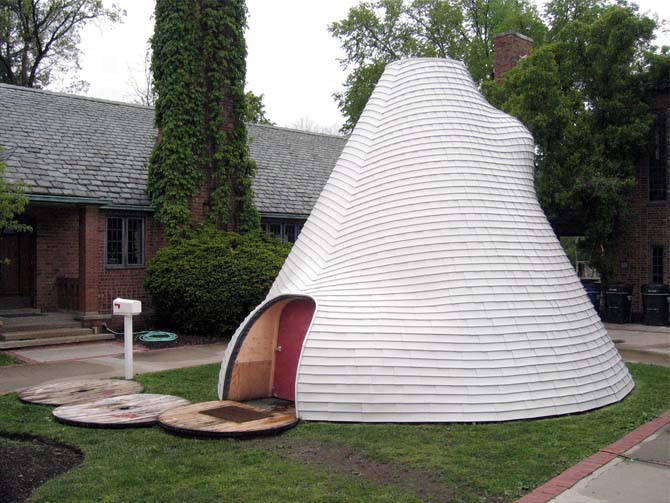Research Journal
-
August 24, 2013
soil and shorelines
1. Talked to Dr Elaine Ingham, chief scientist at the Rodale Institute in PA (formerly at OSU). She’s a Soil Diva: an energetic, brilliant, committed soil expert and the author of my favorite quote from the film Symphony of the Soil*:
“It’s Times Square on New Years Eve in the soil, all the time”.
I already found out that half the microorganisms I drew are “bad guys,” which really upset Dr. Ingham. I clearly need some schooling. I’m going to learn this fall, soil analysis and microvideography, at least superficially (bad pun sorry I bet soil can engender lots of those) .
* I’m indebted to Stefani Bardin for turning me onto the film.
2. I went to Pomarius, Peter Schoonmaker’s brother-in-law’s nursery in part because it’s spectacular (and full of foreigners:) but also because the city’s doing sewer lines and there was a big cut outside along the curb, in which a lot of clay was exposed. So we grabbed a shovel and started to make for the trench when a worker came and forbade us to get in there – and dug the bucket of clay up himself. Stinky, but awesome. Now I have material to test this winter til I get back out on the river.
He also gave us a tour inside the manholes – flowing waters, nasty pipes suggesting toilets (as Timothy Morton likes to say, “There’s no there there”), and stagnant shit under the nursery’s plein aire dining area, with strange stumpy crickets clustered around the upturned lid…
My hosts Sasha and Michael, the proprietors of the brilliant wine and food spot in the SE, Cyril’s at Clay Pigeon Winery, think I make all this stuff up, just ride my bike all day long and come home with weird stories:)
It’s been lux, and I am sad to be going home.
-
August 22, 2013
INTIMACY AND INFORMATION.

Left: magnified view of the area just north of the St Johns Bridge; Right: lower Willamette / Columbia River framing North Portland with Sauvie Island and Washington State at the top Drawing is a way of knowing – that’s such an obvious statement but it’s true.
I started work on a way to visualize the Willamette and Columbia Rivers, flanking North Portland, the 11 mile superfund site and the startling fact that so many uses and agents (typologies, species, agendas, wants and wills, actions and reactions) are actually crowded together. I’m not at all certain of this method, but I am currently set on remaining agnostic to differences and placing no value or codification on the system as a whole. My methods include:
An accurate tracing from USGS topographic maps (just the river ways currently), which taught me a lot both through the intimacy of drawing the rivers – how the shore moves, how it got moved, where it got straightened and filled in by the USACE. You can see some older maps here. Drawing offers time and movement, and tracing offers freedom from too much interpretation.
I got some atlases from Portland’s Bureau of Planning and Sustainability (thanks to Sallie Edmunds) which were very helpful start points at understanding the various use-values of the shoreline.
To actually get tangible information (cars, chemicals, spa services, cement factories:– Use the 2001 Willamette River Atlas to keep the whole picture in hand,
– Then go to google maps, where I can determine a shoreline address by using their “what’s here?” feature,
– Input that address into portlandmaps.com, navigating that rich interface (need to find prostitution? noise, garbage, hazards or elevation? This site can help you), to see what businesses are within a 1/2 mile radius of the spot I found. I hope I’m wrong and there’s a GIS database that lists all leaseholders as well as leasees, as many of the major real estate holdings are simply “Port of Portland” or “Toyota” and they rent out space. This also is a getting-to-know-you strategy.
-The shoreline can be further researched by going to the Oregon DEQ’s Land Quality Environmental Cleanup Site Information Database, and inputting some of the big land holders I found on the River Atlas, (like Schnitzer Steel) which is a goldmine (snort) of the perhaps less desired agents of influence like barium, lead, antimony, which have leached from prior practices.I can sense how this map could obsess me – going through the sites is minor sleuth work, and although it’s exhausting, it has rhythm. Something(s) is missing though, which I look forward to unearthing.
-
August 21, 2013
butterfly magic
YEP. How is this possible?
From Oregon Metro today, Zoo releases 850 endangered butterflies into wild
Precious excerpts:
Once common along the Oregon coast, the Oregon silverspot was reduced to four Oregon populations by the 1990s. The species was listed as threatened by the U.S. Fish and Wildlife Service in 1980 – one of two Oregon butterflies listed as threatened or endangered under the U.S. Endangered Species Act.
“They face a lot of obstacles,” Andersen said. “Development, motor vehicles, bad weather, pesticides, invasive species, natural predators like spiders.…”
In addition to releasing pupae, the Oregon Zoo raises and plants thousands of early blue violets, on which the Oregon silverspot depends, into butterfly habitat.
“When the caterpillars hatch, they’re tiny – just about the size of Abe Lincoln’s nose on a penny,” Andersen said. “But they will eat more than 300 nickel-sized violet leaves before they’re ready to pupate.”
Last summer, before the final batch of 2012 pupae were sent to their new beachfront homes, Oregon Zoo photographer Michael Durham captured what is believed to be the first time-lapse video of a silverspot caterpillar transforming into a chrysalis.
“What he captured was nothing short of magical,” Andersen said. “When a caterpillar pupates, all of its molecules literally liquefy, and it reformulates as a butterfly. Sometimes you need to have a meltdown in order to change your life.”
-
August 15, 2013
animalcules
Start by replicating Antonie van Leeuwenhoek‘s famed microorganism (a rotifer) (replete with crowns).
Continue on a folk art expedition to make heroes out of our invisible microbial community members.
There is no reason to the system yet, whatsoever.
Don’t know where it’s going, but they are REALLY fun to draw: -
August 13, 2013
plastic beaches, the polymer vortex

Astoria, OR 
10 days ago I went to the OR coast – around Astoria, the mouth of the mighty Columbia River, with 15 Japanese continuing ed students to survey the beach plastics and look at and for tsunami debris. Oregon is twinned, connected to Japan through a strong east/west current. In addition, long-livin’ plastics suspended in the N Pacific Gyre, the trash vortex bigger than Texas and described as a 300 foot deep cloud of plastic bits, broken into ever-smaller bits by the sun’s UV, masquerading as plankton, and colorful confetti, gets dumped back out, into the currents, and lands on the coastal beaches.
We spent an hour cleaning – if you can call it that – I sat in one place for 45 minutes, overturning sticks and small logs to find an almost-solid layer of post-consumer plastic bits, nurdles (pre-consumer plastic resin pellets), oyster farm tubes, styrofoam nuggets, to mention a few, from the vast polymer taxonomy.

Marc Ward of Sea Turtles Forever, a committed beach plastic clean up leader and educator, with some of the PNCA crew I can’t seem to draw myself away from plastic – what’s been coined The Plastisphere.
To date, though, how the Anthropocene has created new ecosystems in the oceans as well as on land has not been much examined.
Such ecosystems are, nevertheless, emerging—as Tracy Mincer of the Woods Hole Oceanographic Institution, in Massachusetts, and Linda Amaral-Zettler of the Marine Biological Laboratory, also in Woods Hole, describe in Environmental Science and Technology. The malign effect of floating plastic debris on seabirds, turtles and other sea creatures is well known. But, as Dr Mincer and Dr Amaral-Zettler have discovered, plastic debris also provides a new habitat for organisms small enough to take advantage of it.
The two researchers collected pieces of plastic from various sites in the North Atlantic. They then examined each using DNA analysis, and also an electron microscope, to see what was living on it. Lots of things were. Altogether, they discovered about 50 species of single-celled plant, animal and bacterial life. Each bit of debris was, in effect, a tiny ecosystem.
As with many ecosystems, the bottom of the food chain was occupied by things that photosynthesise. These included unicellular algae called diatoms and dinoflagellates, and photosynthetic bacteria known as cyanobacteria. Usually, such creatures swim freely in the ocean. They therefore have to work hard to stay near the surface, where light for photosynthesis is abundant. By hitching a ride on a piece of floating plastic, they can stay near the surface without effort.
I recently found a smitten-inducing blog post by artist Max Liboiron, on a blog called Discard Studies that she co-authors with Robin Nagle and Eric Friedman. I really love the trajectory of the entire post which concludes with:
Our bodies are the newest sink in a long lineage of industrial ecosystems, and can even be considered an extension of the Plastisphere.
What do waste ecosystems like the Plastisphere, The Rocky Mountain Arsenal National Park, and our own bodies mean for notions of pollution as they pertain to harm and health? How do they complicate truisms of clean up and restoration? How do they expand the notion of industrial ecosystems as intentional versus unintentional, contained versus planet-wide? Most importantly, how do we re-conceptualize pollution when purity is no longer empirically possible? These questions are becoming more pressing as our current definitions of pollution, founded more than a century ago, are being outmoded by manifestations of pollution in the twenty-first century.

Microplastic Ingestion by Zooplankton Another post on the subject: Microbes make cozy homes in ocean’s Plastisphere
I also want this book Accumulation: The Material Politics of Plastic, but it’s Routledge, dammit, and they are notoriously, ridiculously expensive ($135!!!)

A timber from Japan in Falcon Cove. Lots of awkward cheering from the crew, as we located tsunami debris, connecting us across time and oceans. -
-
August 13, 2013
urban shangri-las
Tags:Here is a news story about a rooftop mountain retreat built illegally atop an apartment building in Beijing:
-
August 13, 2013
bibliography
(in progress, running list. Thanks to Peter Schoonmaker, Kimberlee Chambers, David Johns, Mike Houck, Nancy Nowacek, and Kathleen Sayce for their suggestions)
BOOKS:
Montgomery, David R. Dirt: the erosion of civilizations. Univ of California Press, 2012.
Lewis, Wayne, and Jeff Lowenfels. Teaming with Microbes: The Organic Gardener’s Guide to the Soil Food Web. Timber Press, 2010.
Solomon, Steve, and Erica Reinheimer. The Intelligent Gardener: Growing Nutrient Dense Food. New Society Publishers, 2012.
Williams, Terry Tempest. Refuge: An unnatural history of family and place. Random House Digital, Inc., 1991. *
Pyle, Robert Michael. Wintergreen: Rambles in a Ravaged Land. Sasquatch Books, 1986. *
Egan, Timothy. The Good Rain: Across Time & Terrain in the Pacific Northwest. Random House Digital, Inc., 1991. *
Kesey, Ken. Sometimes a great notion. Penguin. com, 2006.
Jonathan Raymond, The Half-Life. Bloomsbury Publishing USA. 2008
Stegner, Wallace. Beyond the hundredth meridian: John Wesley Powell and the second opening of the West. Penguin. com, 1992.
Daily, Gretchen C., ed. Nature’s services: societal dependence on natural ecosystems. Island Press, 1997.
Marris, Emma. Rambunctious garden: saving nature in a post-wild world. Bloomsbury Publishing USA, 2011.
Lichatowich, Jim, and James A. Lichatowich. Salmon without rivers: a history of the Pacific salmon crisis. Island Press, 2001.
Florida, Richard. Cities and the creative class. Routledge, 2004.
Heise, Ursula K. Sense of place and sense of planet: The environmental imagination of the global. Oxford University Press, 2008.
Costa, Rebecca. The Watchman’s Rattle: Thinking Our Way Out of Extinction. Vanguard, 2010.
Lakoff, George, and Mark Johnson. Metaphors we live by. University of Chicago press, 2008.
Lerner, Rebecca. Dandelion Hunter: Foraging the Urban Wilderness. Globe Pequot, 2013.
Morton, Timothy. The ecological thought. Harvard University Press, 2010.
PUBLISHED PAPERS AND ARTICLES:
Garibaldi, Ann, and Nancy Turner. “Cultural keystone species: implications for ecological conservation and restoration.” Ecology and Society 9.3 (2004): 1. *
Nuñez, Martin A., and Daniel Simberloff. “Invasive species and the cultural keystone species concept.” Ecology and Society 10.1 (2005): r4. *
Bowen-Jones, Evan, and Abigail Entwistle. “Identifying appropriate flagship species: the importance of culture and local contexts.” Oryx 36.2 (2002): 189-195. *
Ragan M. Callaway and Wendy M. Ridenour 2004. “Novel weapons: invasive success and the evolution of increased competitive ability.” Frontiers in Ecology and the Environment 2: 436–443 *
Canfield, M, ed. “Introduction.” Field Notes on Science and Nature, 1-18. Cambridge, MA: Harvard University Press, 2011 *
Berg, Peter, and Raymond F. Dasmann. “Reinhabiting California.”Environmentalism: Critical Concepts 2 (2003): 231-236. *
Lowry, J. L. “In my town.” Orion: Nature/Culture/Place, Winter (1998): 33-44 *
Ceurstemont, Sandrine. “Inevitable insectivores? Not so fast.” New Scientist219.2924 (2013): 34-37.
van Leeuwen, Cornelis, et al. “Influence of climate, soil, and cultivar on terroir.” American Journal of Enology and Viticulture 55.3 (2004): 207-217. *
Doyle, Brian, “The Creature Beyond the Mountains.” Orion September/October(2011). *
Soulé, Michael E., et al. “Ecological effectiveness: conservation goals for interactive species.” Conservation Biology 17.5 (2003): 1238-1250. *
Johns, David. “The War on Nature—Turning the Tide?.” Ignoring Nature No More: The Case for Compassionate Conservation (2013): 237.*
Johns, David. “With Friends Like These Wilderness and Biodiversity Do Not Need Enemies.” Keeping the Wild: Against the Domestication of Earth (forthcoming)
Trewavas, Anthony. “Aspects of plant intelligence.” Annals of Botany 92.1 (2003): 1-20.
Regional Conservation Strategy: http://theintertwine.org/RegionalConservationStrategy *
Biodiversity Guide For The Greater Portland-Vancouver Region:http://theintertwine.org/BiodiversityGuide *
Houck, M. and J. Labbe. 2007. Ecological Landscapes: connecting neighborhood to city and city to region. Metropolitan Briefing Book, pgs. 37-48. http://www.pdx.edu/ims/2007-briefing-book *
Paul Kingsnorth. “Dark Ecology.” Orion January/February (2013) *
Wendell Berry. “Manifesto: The Mad Farmer Liberation Front” The Country of Marriage (1973) *
-
August 13, 2013
productive meandering
Here’s a mishmash of maybes, that got me really excited last week.
Meeting filmmaker Matt McCormick:
Seeing his awesome studio on River St between the cement and grain silos, just S of the Fremont St Bridge. With a hole in the parking lot chain link you have sneaky in/out access to the Willamette River, and possibly a site for conversations and some local tea:
Reading Garibaldi, A. and N. Turner. 2004. Cultural keystone species: implications for ecological conservation and restoration, and musing about what and who constitute culturally and ecologically significant (albeit geotemporally brief) keystone species (cows and concrete and corn, to name a few provocateurs):
Ecologists have long recognized that some species, by virtue of the key roles they play in the overall structure and functioning of an ecosystem, are essential to its integrity; these are known as keystone species. Similarly, in human cultures everywhere, there are plants and animals that form the contextual underpinnings of a culture, as reflected in their fundamental roles in diet, as materials, or in medicine. In addition, these species often feature prominently in the language, ceremonies, and narratives of native peoples and can be considered cultural icons. Without these “cultural keystone species,” the societies they support would be completely different. An obvious example is western red-cedar (Thuja plicata) for Northwest Coast cultures of North America. Often prominent elements of local ecosystems, cultural keystone species may be used and harvested in large quantities and intensively managed for quality and productivity. Given that biological conservation and ecological restoration embody human cultures as crucial components, one approach that may improve success in overall conservation or restoration efforts is to recognize and focus on cultural keystone species. In this paper, we explore the concept of cultural keystone species, describe similarities to and differences from ecological keystone species, present examples from First Nations cultures of British Columbia, and discuss the application of this concept in ecological restoration and conservation initiatives.
– Ecology and SocietyFinding a motherlode of Willamette River Superfund info, which I’m aggregating here:
Connecting with Sara Huston, who, with her partner John, designs under the name The Last Attempt at Greatness. We are going to talk about some structures we might make, to serve really local things (like Willamette chai or English ivy).
-
August 12, 2013
delicious streets
Very little, I’m slightly embarrassed to confess, makes a place more vibrant than knowing how much of it is edible.
Since I went on Becky Lerner’s First Ways foraging tour near Alberta Street last week, neighborhoods and lawns have come alive. One of the many things I appreciated about Becky is her blindness to speciesism: she’s interested in eating, healing, and smoking the neighborhood, not deeming what’s native or foreign.
Read her blog, if not her book.
Rebecca Lerner, sitting in an alley off Alberta Street preparing a legal smoke mixture We did a 2 hour foraging tour, focused on what might constitute a psychotropic smoke mixture (noting illegal), but also nibbled and snipped (only street side, following the laws of usufruct*) our way through a mere 2 block radius, which included
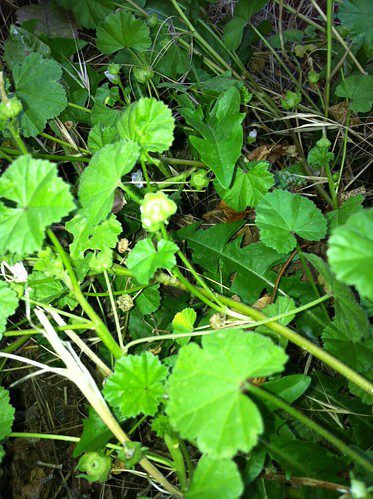
Mallow, a mucilagenous thickening agent, which belies the fact that young flower buds are like edamame 
Kousa Dogwood (which I’ve eaten as garnish at Kyo Ya, my favorite esoteric and luxurious teeny Japanese restaurant in the LES) 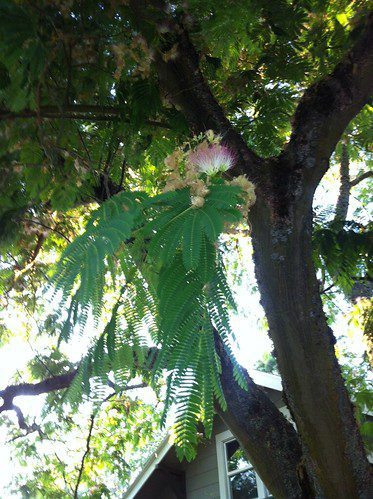
Mimosa, an antidepressant, used in TCM 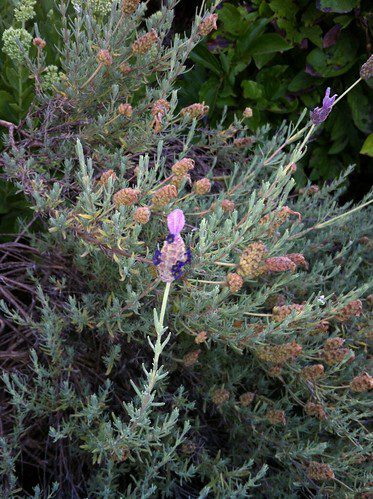
Spanish lavender. Russian sage, Spanish lavender and Lemon balm, both of which are amazing additions to a smoke mixture, with a base of mullein Hen and chicks, whose leaves are edible

Sedum, edible leaves 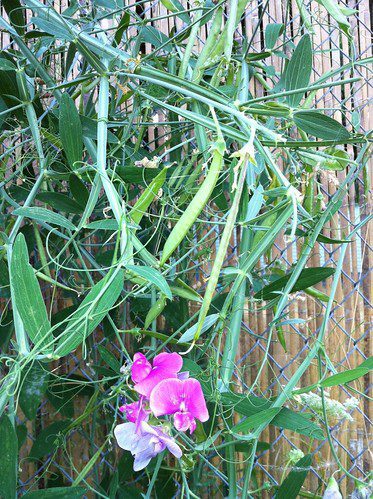
Everlasting pea, whose flowers are edible and orchid-like beautiful. Becky said not to eat the beans, TBD… 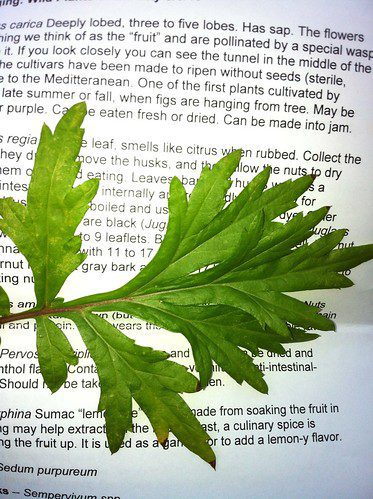
Mugwort, used as tea, medicinal, used in traditional midwifery et al. If I remember right, you can drink it to encourage vivid dreams, or even put it under your pillow, purportedly. 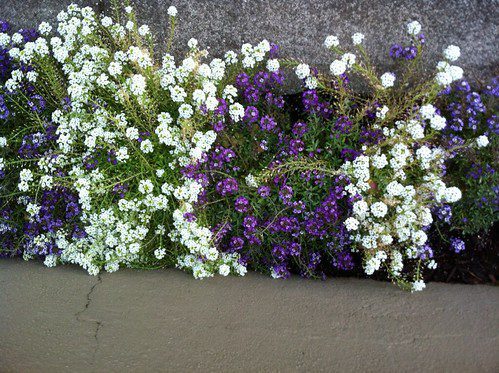
Sweet alyssum, which I’ve always loved for its subtle honey fragrance (this was our only lawn infraction) 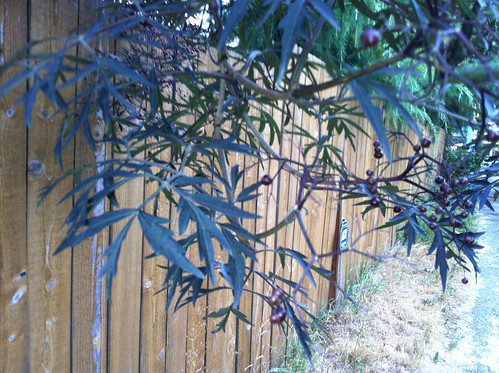
A cultivar of elderberry (uh, eat berries) and American poppy, to make a sedative tincture.
* * * * * * *
*The ancient legal principle of usufruct broadly dictates that private property can be used for the public good so long as it’s not damaged in the process. This is of note to the urban forager, as it suggests that fruit and other plant foods grown on private land can be harvested by passersby. A stricter and far less hazardous foodie interpretation of usufruct means that ripe citrus tree, whose trunk meets the soil inside your neighbor’s yard but whose laden branches overhang the sidewalk, can be shorn of a few bits of fruit so long as you don’t harm the tree or any other property in so doing, or abuse the privilege; that is, take only as much as you can consume.
– LA Weekly, shout out to Fallen Fruit
